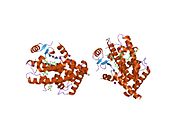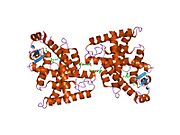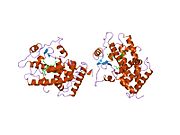Peroxisome proliferator-activated receptor delta
Ensembl | |||||||||
|---|---|---|---|---|---|---|---|---|---|
| UniProt | |||||||||
| RefSeq (mRNA) | |||||||||
| RefSeq (protein) | |||||||||
| Location (UCSC) | Chr 6: 35.34 – 35.43 Mb | Chr 17: 28.23 – 28.3 Mb | |||||||
| PubMed search | [3] | [4] | |||||||
| View/Edit Human | View/Edit Mouse |
Peroxisome proliferator-activated receptor delta (PPAR-delta), or (PPAR-beta), also known as Nuclear hormone receptor 1 (NUC1) is a nuclear receptor that in humans is encoded by the PPARD gene.[5]
This gene encodes a member of the peroxisome proliferator-activated receptor (PPAR) family. It was first identified in Xenopus in 1993.[6]
Function
PPAR-delta is a nuclear hormone receptor that governs a variety of biological processes and may be involved in the development of several chronic diseases, including diabetes, obesity, atherosclerosis, and cancer.[7][8]
In muscle PPARD
PPAR-delta may function as an integrator of
This protein has been shown to be involved in differentiation, lipid accumulation,[14] directional sensing, polarization, and migration in keratinocytes.[15]
Role in cancer
Studies into the role of PPAR-delta in cancer have produced contradictory results. Although there is some controversy, the majority of studies have suggested that PPAR-delta activation could result in changes that are favorable to cancer progression.[16] PPAR-delta favours tumour angiogenesis.[17]
Tissue distribution
PPAR-delta is highly expressed in many tissues, including
Knockout studies
Ligands
PPAR-delta is activated in the cell by various fatty acids and fatty acid derivatives.
Agonists
Although its drug development was discontinued due to animal studies suggesting an increased risk of cancer, GW501516 has been used as a
Interactions
Peroxisome proliferator-activated receptor delta has been shown to
References
- ^ a b c GRCh38: Ensembl release 89: ENSG00000112033 – Ensembl, May 2017
- ^ a b c GRCm38: Ensembl release 89: ENSMUSG00000002250 – Ensembl, May 2017
- ^ "Human PubMed Reference:". National Center for Biotechnology Information, U.S. National Library of Medicine.
- ^ "Mouse PubMed Reference:". National Center for Biotechnology Information, U.S. National Library of Medicine.
- S2CID 23506853.
- S2CID 25098754.
- ^ PMID 11818483.
- PMID 16476485.
- ^ PMID 25945080.
- PMID 18674809.
- PMID 16969348.
- PMID 16492734.
- ^ "Entrez Gene: PPARD peroxisome proliferator-activated receptor delta".
- PMID 15102088.
- PMID 17682064.
- ^ PMID 32375405.
- PMID 31842402.
- PMID 18442472.
- PMID 10866668.
- ^ Mol. Pharmacol. 77:171-184, 2010
- PMID 16960684.
- S2CID 261023817.
- PMID 37386786.
- ^ Koh B (22 March 2013). "Anti-doping agency warns cheats on the health risks of Endurobol". The Conversation. Retrieved 5 September 2023.
- S2CID 231899376.
- PMID 22977012.
- S2CID 19487189.
- ^ PMID 11867749.
Further reading
- Chong HC, Tan MJ, Philippe V, Tan SH, Tan CK, Ku CW, Goh YY, Wahli W, Michalik L, Tan NS (March 2009). "Regulation of epithelial-mesenchymal IL-1 signaling by PPARbeta/delta is essential for skin homeostasis and wound healing". The Journal of Cell Biology. 184 (6): 817–831. PMID 19307598.
- Tan NS, Michalik L, Desvergne B, Wahli W (May 2005). "Genetic- or transforming growth factor-beta 1-induced changes in epidermal peroxisome proliferator-activated receptor beta/delta expression dictate wound repair kinetics". The Journal of Biological Chemistry. 280 (18): 18163–18170. PMID 15708854.
- Tan NS, Michalik L, Di-Poï N, Ng CY, Mermod N, Roberts AB, Desvergne B, Wahli W (October 2004). "Essential role of Smad3 in the inhibition of inflammation-induced PPARbeta/delta expression". The EMBO Journal. 23 (21): 4211–4221. PMID 15470497.
- Di-Poï N, Tan NS, Michalik L, Wahli W, Desvergne B (October 2002). "Antiapoptotic role of PPARbeta in keratinocytes via transcriptional control of the Akt1 signaling pathway". Molecular Cell. 10 (4): 721–733. PMID 12419217.
- Tan NS, Michalik L, Noy N, Yasmin R, Pacot C, Heim M, Flühmann B, Desvergne B, Wahli W (December 2001). "Critical roles of PPAR beta/delta in keratinocyte response to inflammation". Genes & Development. 15 (24): 3263–3277. PMID 11751632.
- Michalik L, Desvergne B, Tan NS, Basu-Modak S, Escher P, Rieusset J, Peters JM, Kaya G, Gonzalez FJ, Zakany J, Metzger D, Chambon P, Duboule D, Wahli W (August 2001). "Impaired skin wound healing in peroxisome proliferator-activated receptor (PPAR)alpha and PPARbeta mutant mice". The Journal of Cell Biology. 154 (4): 799–814. PMID 11514592.
External links
- PPAR+delta at the U.S. National Library of Medicine Medical Subject Headings (MeSH)
This article incorporates text from the United States National Library of Medicine, which is in the public domain.








